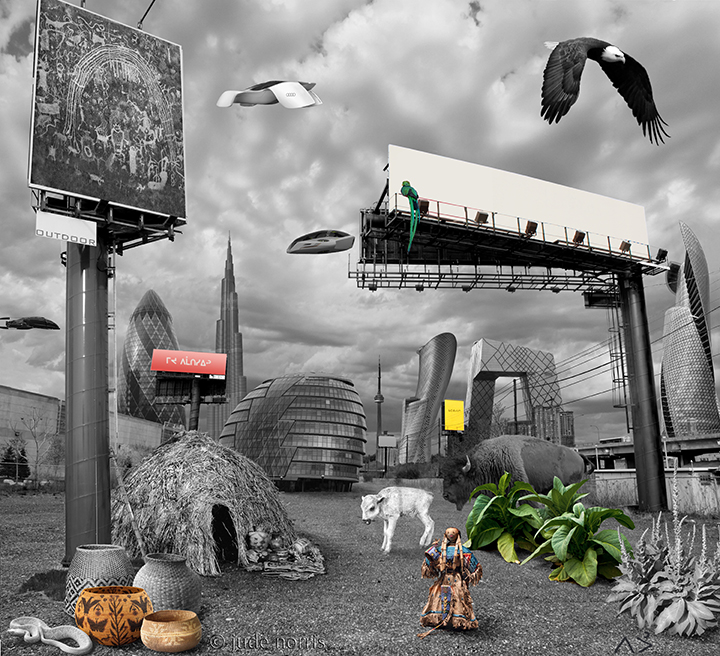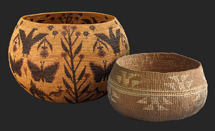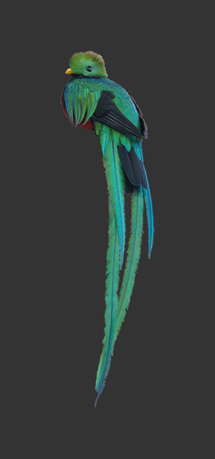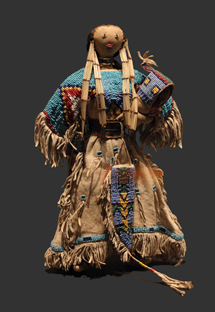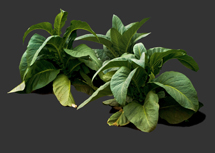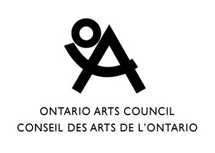PLEASE CLICK ON IMAGE TO ENLARGE & VIEW IN LIGHTBOX
INFORMATION ON LANDSCAPE ELEMENTS:
objects, animals & plant medicine
White Buffalo Calf
White Buffalo are very rare and very sacred in First Nations culture. Over 2,000 years ago, a beautiful spirit being, the White Buffalo Calf Woman, visited the people of the Lakota Nation, bringing them numerous teachings, ceremonies and gifts to facilitate living a positive, abundant and spiritually connected life.
She instructed people to make each step like a prayer, and taught that the creative work and energy of women was as valuable as that of male warriors. She also brought the sacred pipe, to be cared for by the Sioux on behalf of all Native people. This pipe is cared for today by its 19th generation traditional pipe keeper, Arvol Looking Horse.
When she left the Lakota people, the White Buffalo Calf Woman also prophesied that she would return to the people again, in another time of hardship. She said the birth of a white buffalo calf would be a sign that it would be near the time when she would return again to purify the world, bringing back harmony, balance and spiritually.
In 1994, the first white buffalo calf was born since 1933, at genetic odds of one in many thousands. Since then, white buffalo calves have been born every year, including an immaculate birth after a gestation period of only 6 months (usual buffalo gestation is 9 months) to a buffalo cow in a Pennsylvania zoo. This birth was confirmed by Arvol Looking Horse. There is also a White Buffalo sanctuary in Oregon with a herd of white buffalo currently numbering 15.
From a traditional/spiritual Native American perspective, the arrival of these white buffalos marks the arrival of a new era on Earth – with dangerous times and great challenges. This is a time of dramatic physical and biological ‘earth changes’ (exemplified by the current pandemic) – yet it also contains the opportunity for a movement into a new level of spirituality for human beings that includes a reconciliation among all races and renewed respect for and harmony with the Earth. The choice is up to us.
Female Plains Bison aka North American Buffalo
There were more that 60 million bison on Turtle Island (aka the Americas) before colonization by Europeans began. They were almost wiped out by the colonists, with numbers down to 541 by 1889.
For Native Nations who lived closely with the Bison (paskwâ mostos in Plains Cree), these animals were our primary source of food and sustenance of all kinds, both physical and spiritual. The depth of our relationship is indescribable. The herds were decimated to make way for cattle and the cattle industry. This genocide was entwined with and as purposeful as the genocide of Indigenous people. Ironically, the cattle industry in the prairies has now all but collapsed, leaving the natural prairie ecosystem as decimated as the bison herds were, and the local non-Native economies bankrupt.
Thankfully, (and again in parallel to Native peoples) the Bison Nation is in recovery, with numbers now above 30,000. The widespread consumption of Buffalo meat is also returning, as more people become aware that it is much healthier than beef. The Bison is now the official national animal of the United States.
Resplendent Quetzal Bird
The Resplendent Quetzal is a strikingly colored bird found in the forests and woodlands, especially in humid highlands, in western Mexico and Baja Verapaz, Guatemala. The male has iridescent green and blue head, wing and tail feathers. Quetzals are just over a foot long, and the males have another two feet or more of tail feathers.
In Mayan culture, the Quetzal bird ( Ket-zal) and the rattle snake share the position of the most revered creatures. The bird is viewed as the “god of the air” and as a symbol of goodness, light, freedom and wealth. It is known as the spirit of the Mayan people and the protector of chiefs. Traditionally, the Quetzal bird’s tail feathers are used as currency and adorn/ed the headdresses of priests and chiefs.
The Mayans married the Quetzal and Serpent (diamondback rattle snake) into Quetzal Coatl, the Plumed Serpent. This deity embodies the movement of Creation and all the effects and beings produced by that movement. Quetzal Coatl is depicted wearing a fantastic headdress, created from hundreds of Quetzal feathers.
The Quetzal bird is now facing extinction, largely due to the destruction of its habitat.
Albino Eastern Diamondback Rattlesnake, the White Snake Deity Papa Damballa, and the Diamondback in Mayan Culture
Eastern diamondback territory includes the south eastern United States. Diamondbacks reach up to 8 ft (2.4 m) in length (with average lengths of 3.5 – 5.5 ft), weigh up to 10 lbs and are the largest venomous snake in North America.
The diamondback featured prominently in the American Revolution, specifically as the symbol of what many consider to be the first flag of the United States of America, the Gadsden flag.
The Diamondback in Mayan Culture
The rattlesnake is also a central sacred animal of the Maya. In their view, the creation of all that there is was carried out in accordance with the geometric design on the scales of rattlesnake.
The South American Rattlesnake has diamond shaped marking similar to Eastern and Western Diamondbacks. The rattlesnake scale designs provide the base for the astronomic arithmetic of the Maya. The scale patterns on a rattlesnake’s body have 13 diamonds with 4 sides each. The dot product of 4 and 13 is 52, a number that is sacred to them, connecting directly to their highly advanced round calendar method of measuring time.
The diamondback is also an important symbol of the current escalating earth changes, which are part of the prophesies in Mayan and other Indigenous cultures. The serpent is shedding its old skin and being reborn to the new knowledge.
Damballah-Wedo, the White Snake
The white snake also represents the Haitian Voodoun snake spirit or wedo, Papa Damballa.
Damballah-Wedo is one of the most revered of the African and Haitian gods or ‘loas’. He is the original servant to the Creator. Papa Damballa created of the world, and in the process, his wife, Ayida-Wedo, the Rainbow. Afterward they became partners in creation, known as the the Serpent and the Rainbow.
Ayida-Wedo is likewise associated with snakes. Because the creative process is seen as shared between male and female, Damballah-Wedo’s veves, or ceremonial symbols, generally depict two snakes rather than just one.
Papa Damballa has many aspects. As loving father to the world, his presence brings peace, harmony and eminates optimism. As a source of life, he is also strongly associated with water and the rain. In addition to being the loa of peace and purity, Damballah-Wedo is the god of platinum and silver. He is the one who grants riches and sustains the world. He is the loa of new life, transformation, and fertility.
One of Papa Damballa’s aspects is Damballah la Flambeau, where he appears in fire form as pure active energy. In this form he melds with the attributes of the Dragon, and represents the outward manifestation of Kundalini, rising from the East.
How The Snake Chose to be in Liberty Village
An interesting thing about the diamondback in Liberty Village #1 is that before it was there, I thought I had completed the image. Then I realized I had to go back and make sure the White Buffalo calf was there. While I was doing this, I also felt suddenly that I ‘must’ include the Quetzal bird (which I knew was associated with the Feathered Serpent of Mayan prophecy) and also a white snake to represent Papa Damballa.
When I was looking for a snake to represent Damballah-Wedo, finding and using a diamondback was intuitive. This rattlesnake just wanted to be there. I had no idea of its importance in Mayan culture until after it was in the landscape, and I started researching the Feathered Serpent.
You will learn more about the Feathered Serpent and the Dragon as you continue your journey through Liberty Village.
Bald Eagle
A North American sea eagle, the Bald Eagle’s territory includes most of Canada and Alaska, all of the contiguous United States, and northern Mexico. An opportunistic feeder which subsists mainly on fish, it is found near large bodies of open water with an abundant food supply and old-growth trees for nesting.
The Bald eagle a body length of 28–40 in (70–102 cm) and typical wingspan between 5.9 and 7.5 ft (1.8 & 2.3 m), with the females being about 25% larger than males. It is a powerful flier, and soars on thermal convection currents. It reaches speeds of 35–43 mph (56–70 kmph) when gliding and flapping, and about 30 mph (48 kmph) while carrying fish. Its dive speed is between 75–99 mph (120–160 kmph), though it seldom dives vertically.
In the US, the Bald Eagle is making a recovery from being on the brink of extirpation. In 1995 the bird was removed from the U.S. federal government’s list of endangered species and transferred to the list of threatened species. It was subsequently removed from the List of Endangered and Threatened Wildlife in the Lower 48 States in 2007.
The Eagle is sacred in Indigenous North American cultures. It is considered a spiritual messenger between humans and the Creator, as it flies the highest of any bird. Eagles are also revered for their powerful vision, ferocity, and commitment to their families.
Eagle feathers are also held sacred, and are central to many Native American spiritual customs and ceremonies. The feathers are often used in traditional healing ceremonies, and traditional and social dances. Pow wow dancers use both the eagle feathers and talons as part of their regalia. It is considered an honor to receive an eagle feather, and they are treated with great care and respect. A feather may be given or often come to person who achieves a task requiring leadership, courage and/or kindness.
Lucy Parker Telles basket
By Lucy Parker Telles aka Pamahas (ca. 1870/1885–1955/6, Mono Lake &
Kucadikadi Northern Paiute/ Southern Sierra Miwok).
Lucy was a renowned and innovative basket weaver, evolving Miwok
tradition by using two colors and at times incorporating geometric designs
inspired by Plains Native artwork patterns.
Hoopa Mush Basket
Collection of the Pope County Historical Society and Museum
Glenwood, MN
The Hoopa (often spelled Hupa) or Natinixwe people live in the area now known as North Western California. They use California hazel, pine root, squaw grass, and maiden hair fern in their beautiful basketry. The baskets have a tight enough weave to hold liquid are traditionally used to cook a nutritious and fortifying mush made from acorn meal. The mush is cooked with and ingenious method using hot rocks and specially designed stirring sticks.
Pre-colonially, acorns were a staple food source for many First Nations, and are still in use by some Native people. They contain large amounts of protein, carbohydrates, and fats, as well as calcium, phosphorus, and potassium, and niacin.
Cherokee white oak basket
Collection of Cherokee Field Office, Cherokee, NC
Cherokee river cane burden basket
Collection of Cherokee Field Office, Cherokee, NC.
Beaded Deer Hide Lakota Doll
circa late 1800’s
Collection of the Smithsonian National Museum of the American Indian.
Dolls were more than toys in pre-colonial First Nations cultures. They were used as a powerful and joyful method of passing down both clothes-making, artistic and social teachings from one generation to the next.
Some artisans (including myself) still carry on this tradition today. Dolls were & are created using a wide variety of materials, just as clothing was. These materials differed depending on what was common to the maker’s territory and culture, and include brain-tanned deer hide, cloth, corn husk, porcupine quills, cut-glass beads, horse hair and other animal hair, shell, pigments, etc.
plant medicine & trees
Tobacco Plants (genetically engineered)
Traditionally, tobacco is a central prayer plant for First Nations people, used in prayer and ceremony as an offering to the Great Spirit and Spirit Guides, Ancestors. Also offered in gratitude to any beings (ie plants or animals) hunted or harvested for human use.
Mullein plant
Native to Europe, Asia and parts of Africa. Now found throughout North America.
Medicinal uses include treatment of respiratory problems, such as chest colds, bronchitis and asthma, strengthening bowels, diarrhea, hemorrhoids, colic, burns, earache & discharge from the ear. Mullein’s anti-bacterial properties make it effective in treating infections & even cold-sores. A poultice can also be used for bruises and to relieve arthritic and rheumatic conditions. In addition, has a calming effect and can be used as a sleep aid.
Used in Europe for lamp wicks & candles. Roman soldiers dipped the flower stalks in tallow to make torches. Also for driving away & safeguarding against evil spirits & magic in both Europe and Asia.
aircraft (left to right)
Mercedes flying car (concept)
Concept car designed by Mercedes-Benz as part of a marketing campaign for their Mercedes’s 2003 E500, which is seen in ‘Men in Black II’, where it turns in to a flying car.
A number of flying car concepts have now been created, as have a few working prototypes. One of the developments that remains to happen to move us into the era of the flying car is the creation of a domestic air traffic control and navigation system that can guide the air-born car traffic in a safe manner.
Audi Avatar flying car (concept)
Designed by Edwin Conan (Yi Yuan), as part of his final year degree project at Royal Melbourne Institute of Technology. The concept car is dated for about 2030.
This 3-seater futuristic car features 4 extremely powerful in-wheel electric motors powered by supercharge-ion batteries. The ultra lightweight aerodynamic body along with the powerful back end, it can accelerate from 0 to 100 km/h in just 2.9 seconds and can achieve the top speed of over 360km/h with responsive handling.
The exterior design of the car is inspired by the form of fabric blown in the wind, and features three glass canopies instead of doors. The interior of the car is as simple and futuristic as the exterior. A single sheet transparent LCD dashboard displays all the essential data such as speed and mileage. A screen in the center of the steering wheel displays digital map. This information can also be projected on the canopy by a head up display.
Honda Fuzo hovering car (concept)
Designer: John Mahieddine.
The 2068 Fuzo is a ‘concept’ flying car. It can take off like vertically like a Harrier Jet, and then fly straight once air-born.
As it takes to the air, the wheels on the car retract, and the four turbine engines move into action, allowing it to reach a maximum speed of 350 mph. The three-seat concept is kept lightweight by the use of materials like carbon fiber, Kevlar and carbon nanotubes.
The Fuzo would have a GPS system that navigates to the destination but also acts as a collision avoidance system. An interesting feature would be airbags on the exterior of the car to protect pedestrians in an accident.
billboard words & images
Foreground Rock Art billboard (far left)
“The Rainbow” – Rochester Panel rock art, near Emery, Utah.
This Petroglyph contains figures in both the Fremont style (700-1300 AD) and the much older Barrier Canyon style.
Cree Good Life billboard (red, mid-left)
Says ‘good behavior, good life’ in Plains Cree language syllabics
Cree beauty billboard (yellow, right background)
Says ‘it is beautiful’ in Plains Cree language syllabics.
foreground and mid-ground architecture
Apache Wikiup (left)
Photograph by Edward Curtis 1903
City Hall (center) London UK
Designed by Norman Foster. Opened in July 2002.
skyline architecture (left to right)
‘The Erotic Gherkin’ London, UK
Designed by Norman Foster and Arup engineers. 591 ft. Completed 2004.
Burj Khalifa Dubai, United Arab Emirates
Design architect, Adrian Smith. Completed 2010.
The tallest man-made structure in the world, at 2,723 ft (829.84 m).
CN Tower Toronto
1,815.4 ft. Completed 1976.
Architect: John Andrews/WZMH Architects
Capital Gate Abu Dhabi
Architectural firm: RMJM. 520 ft (160 m). Completed 2011.
The building leans a record-breaking 18 degrees.
China Central Television Headquarters Beijing
Architects: Rem Koolhaas, Ole Scheeren of Office for Metropolitan Architecture.
768 feet (234 m). Completed 2008.
Mode Gakuen Spiral Tower Nagoya, Aichi, Japan
Architect: Nikken Sekkai. 558 ft. Completed 2008.
One of 3 towers housing the schools of fashion design, computer science and medicine.
When you have finished your journey through the Response-Hive City,
I invite you to read the project description.
This artwork is available for sale as a limited edition, archival-quality inkjet print.
Please email Jude@JudeNorris.com for information & pricing.
